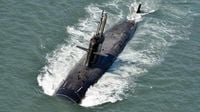On the bustling waterfront of Dalian, China, the sight of pensioners singing patriotic anthems against a backdrop of cranes and colossal ships under construction might seem like an everyday slice of local life. But for policymakers in Washington and New Delhi, the view from Suoyuwan Park is anything but ordinary. It’s a front-row seat to a seismic shift in global naval power—one that is rapidly redefining the balance of strength across the world’s oceans.
According to BBC, China has become the undisputed powerhouse of global shipbuilding, now commanding more than 60% of worldwide orders as of September 2, 2025. The scale of this dominance is, in the words of Nick Childs from the International Institute for Strategic Studies, "extraordinary… in many ways eye-watering." Childs estimates that China’s shipbuilding capacity is roughly 200 times that of the United States. This isn’t just about commercial shipping, either. China’s shipyards—especially in Dalian, Guangzhou, Jiangnan, and Hudong-Zhonghua—are churning out warships at a pace that has left the rest of the world scrambling to keep up.
Between 2019 and 2023, these four shipyards produced 39 warships with a combined displacement of 550,000 tonnes, according to a study by the Center for Strategic and International Studies (CSIS). To put that in perspective, the entire Royal Navy’s tonnage is around 399,000 tonnes. The People’s Liberation Army Navy (PLAN) now boasts 234 warships, surpassing the US Navy’s 219 vessels. While the US still holds an edge in total tonnage—thanks to its larger aircraft carriers—the numerical advantage is increasingly swinging toward Beijing.
Yet, China’s naval ascent isn’t without its limits. As BBC analysis points out, the PLAN currently operates only two aircraft carriers and has fewer submarines than the US Navy. Chinese submarines, while numerous, are generally less technologically advanced and are designed primarily for the shallower waters of the South China Sea. Long-range operational capability remains a work in progress. However, recent satellite imagery from Hainan indicates a major expansion of naval bases, including facilities for Jin-class submarines capable of carrying nuclear missiles. Social media footage has also revealed the development of unmanned underwater drones, hinting at a future where surveillance and undersea warfare could be revolutionized.
"The big question is how long will it take for the technology to mature," says Matthew Funaiole of CSIS. China’s rapid shipbuilding is underpinned by a policy known as "military-civilian fusion," where commercial shipyards are primed to switch to naval production at a moment’s notice. "This is a politically motivated agenda to merge both the commercial and military entities together," Funaiole explains. In a protracted conflict, the ability to quickly replace or augment naval forces could prove decisive. "If you have shipyards that quickly produce new ships, this is a huge strategic advantage," he adds.
China’s motivation, as reported by BBC, is deeply rooted in history. President Xi Jinping often invokes the nation’s "bitter memories of foreign assaults" during the Qing dynasty as a rallying cry, vowing that China will never again be humiliated. Naval strength has thus become a symbol of national pride and a promise of security against foreign threats.
In a bold display of its military achievements, China is preparing for a parade that will showcase anti-ship missiles, hypersonic weapons, and underwater drones—an event to be attended by Russia’s Vladimir Putin and North Korea’s Kim Jong Un. The message to the West is clear: China is no longer content to "hide its strength and bide its time." Yet, Professor Hu Bo of Peking University insists, "We have no interest in interfering in the business of other countries, especially militarily." The one glaring exception is Taiwan. While Beijing denies any set timetable for "reunification," it has not ruled out the use of force. US officials have warned of a possible invasion attempt by 2027, a scenario that China dismisses but refuses to categorically reject.
China’s navy is also pushing its boundaries beyond the South China Sea. Recent drills have included the circumnavigation of Australia’s coastline and carrier exercises near Japan—maneuvers that, while legal under international law, have raised alarms among regional neighbors. "They still have a significant way to go, but they are certainly pushing the boundaries," concludes Childs.
As China asserts itself at sea, another Asian giant is moving to shore up its own maritime defenses. On the same September day, India is finalizing two landmark submarine acquisition programs worth over ₹1 lakh crore as part of the government’s Make in India initiative, according to recent reporting. The first project, already approved by the Defence Ministry, involves the construction of three additional Scorpene-class diesel-electric submarines at Mazagon Dock Shipbuilders in collaboration with France’s Naval Group. This contract, valued at around ₹36,000 crore, builds on the six Scorpenes already commissioned and is expected to be signed once technical and commercial negotiations are wrapped up.
Running in parallel is the far more ambitious Project-75 (India), or P-75(I), pegged at ₹65,000 crore. This program will deliver six next-generation stealth submarines equipped with advanced propulsion and weapons systems. Though the project has been in the pipeline since 2021, officials anticipate that negotiations on cost and execution will continue for another six to nine months before a final agreement is reached.
The significance of these deals goes far beyond mere numbers. They represent a crucial push toward indigenization, with domestic shipyards expected to play a central role and critical technologies set to be transferred to Indian industry. This aligns with India’s broader goal of reducing dependence on foreign imports and fostering self-reliance in advanced defense manufacturing. The timing couldn’t be more critical. With China’s naval presence growing rapidly in the Indian Ocean, Indian defense planners see these new submarines as vital for maintaining a strategic balance in regional waters.
Officials underscore that the forthcoming submarines will provide the Indian Navy with a much-needed edge in stealth, endurance, and strike capabilities. Beyond the battlefield, the projects are also expected to create a multiplier effect across India’s shipbuilding and ancillary sectors, combining national defense with industrial growth and employment generation. While cost negotiations remain complex, the expenditure is viewed as an investment in both security and strategic autonomy. If concluded on schedule, these submarine programs could transform India’s maritime posture over the next decade, helping safeguard trade routes, protect the coastline, and assert influence throughout the Indo-Pacific.
What began as patriotic karaoke in a Chinese park and a flurry of negotiations in Indian shipyards has become a defining contest for naval dominance in the 21st century. Both countries are racing to secure their interests at sea, each with its own blend of historical memory, industrial might, and strategic ambition. The world is watching closely as Asia’s two giants reshape the future of maritime power—one ship, and one submarine, at a time.




